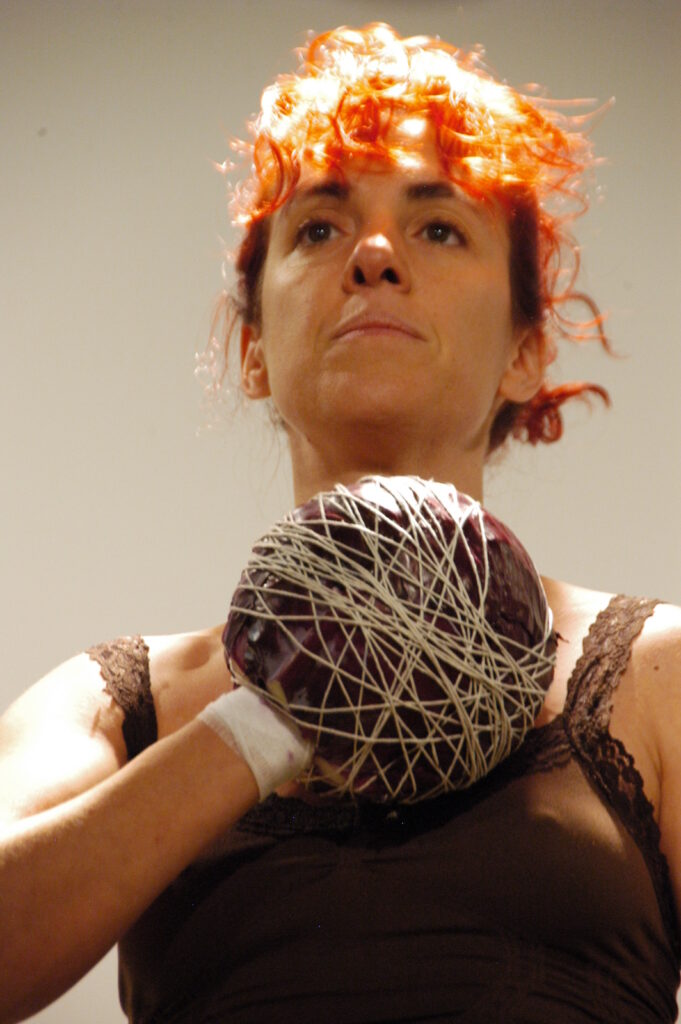By Elaine Wong
In a previous statement about her art, Sylvette Babin described herself as un être hybride, a hybrid being without a fixed discipline. Eight years later, the idea of hybridity, of being able to combine and draw from different media, is still a positive facet of her art. She has created and choreographed art from a variety of different perspectives—writing, video, performance, installation, visual art, and more—and though at this point in her artistic career she finds herself leaning more towards performance, she states that the connections between different media are crucial, and not always able to be separated. Nor is it necessarily a valuable thing to be able to separate them, for she is adamant that she be able to use the media she feels are necessary to create her message. While in general she would love to be able to draw more heavily upon video and site-specific performance, unfortunately the time is not always available to her.
One theme she has found that crosses the borders of different media is the idea of art as an exploration of space and movement. Even within her canvas as a visual artist, she felt that the work’s engagement came from its composition and the movement of the brushes, while installation and sculpture functioned as tableaux of motion, crystallized within space.
This theme of space-play is also tied to her ideas of sound-play, wherein she manipulates sound and its creation, changing the physical manifestations of sound. Despite having lost the use of one ear, Babin possesses an intuitiveness with sound. For instance, one of her first video installations was a series of three looped videos on fifteen monitors, in which she focused on the combined experience of sound and image together, creating overlapping layers of sound. A visitor to the installation commented on the polyphonic nature of the installation, which surprised and pleased Babin, whose world is purely monophonic. She states emphatically, however, that she creates sound, and not music. She listens to the sound of objects, hearing the notes within them; she plays with the natural capabilities of all objects to create sound.
This physicality of sound is one of the many things about it that appeals to Babin, for while image and text must always be processed through the mind to be understood, she is intrigued by how sound is interpreted first and foremost by the body and felt as a genuinely physical experience. The link between body and sound is a concept that she has explored in the Breath series of performances around the world. Starting in a children’s wading pool with a harmonica and a stovepipe-turned-amplifier, she ran around the wading pool, letting her breath flow naturally through the harmonica. By just letting her breath go, without trying to control it to produce specific tones, Babin tied the sound of the breath directly to its production by the body and to the visual image of her motion, linking the three into a single action. In Poland she performed a piece along the same vein. Lying with forty pounds of grease stacked in cubes around her face, her only means of interaction with and awareness of the audience beyond the wall of fat was a single breathing tube attached again to a harmonica. In Italy this was performed with giant pile of tomatoes, in Germany with soil, and in France with ice. The sound of her breath filtered through the harmonica created a complex web of sound based on the speed and depth of her breathing.
Each of these performances, as well as her performance last week in the festival, is accompanied by a strong visual aspect that she feels is complementary to the aural exploration of her work. In each case she feels that the audio would not work on its own but builds off the context of the situation to give it meaning, since the sound is created by action within the performance. However, she is unworried that the striking visuals of her performances will distract from the aural aspects, because the sound is often the first point of contact with the audience, as well as the most enduring. Babin feels that sound, in the context of her performances, should be organic/acoustic, for the act of creating of sound with the body is just as much a part of the performance as is the manipulation of it.
“The body is always there in performance. The body is the source of motion, the source of intention. Everywhere there is creation there is the body to create it.” — Sylvette Babin

